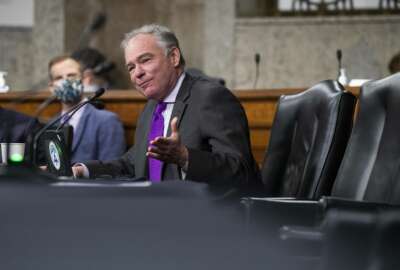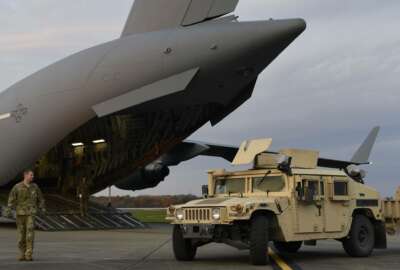
Marines’ bid to replace helicopter delayed, costs rising
The Marine Corps' bid to replace its heavy lift helicopter is running into heavy downdrafts. Federal Drive spoke with the Government Accountability Office's Jon...
Best listening experience is on Chrome, Firefox or Safari. Subscribe to Federal Drive’s daily audio interviews on Apple Podcasts or PodcastOne.
The Marine Corps’ bid to replace its heavy lift helicopter is running into heavy downdrafts. Dubbed the CH-53K, the chopper is 15 years into development. Yet it still has technical problems and costs spinning out of control like a loose rotor blade. For the latest details, the director of the contracting and national security acquisitions team at the Government Accountability Office, Jon Ludwigson, spoke to Federal Drive with Tom Temin.
Interview transcript:
Tom Temin: Jon, good to have you back.
Jon Ludwigson: Thank you so much for having me Tom.
Tom Temin: First of all, give us a quick background on this program, because it has been running for an amazingly long time.
Jon Ludwigson: Yeah, this is a very important capability for the Marine Corps. It’s really one of the critical links to move Marines and equipment from ship to shore and many miles inland in many cases. And the CH-53E, which is the predecessor helicopter, was facing some challenges in careering the heavier equipment in London. So 15 years ago, they began the journey to create the 53k, which is a considerable upgrade in terms of lift capability and the ability to particularly put heavy equipment on slings underneath the helicopter and move it inland. As you noted, it’s been a while, they’re getting close to wrapping up developmental testing, which would leave them poised to do the operational test to see if the equipment meets their needs.
Tom Temin: But isn’t this the basic helicopter that goes back to 1960 that they’re just reworking? Or is it an all new frame?
Jon Ludwigson: Well, it’s a considerable upgrade both, as I mentioned in terms of its lift capability, it’s capable of lifting considerably more weight. Really, the threshold requirement for being able to lift external weight is 27,000 pounds versus 8,000 pounds that the 53E could lift, and the overall carrying capacity is up considerably as well. So that in and of itself required upgrades, obviously, to the engines and rotor system, in order to provide that lift. Internal dimensions are bigger, you can actually drive a Humvee inside of one of these. Can be reconfigured to carry troops without needing to reconfigure the floor so they can put troops in and pull the Humvee in without doing considerable changes to the inside. Fly by wire configuration, which gives them some more flexibility in terms of being able to hopefully be resilient in the event that it worked to take some damage.
Tom Temin: Sure. So 15 years in development, then what is taking so long? I mean, what did you find that their scheduling system doesn’t seem to really reflect reality?
Jon Ludwigson: So a lot of problems were discovered along the way to here. The upgrades to the engine created a challenge with the engine reingesting the exhaust gases, which are hot. And so when the engine would reingest the hot gases, it would cause the engine to run hotter and sometimes shut down. The main rotor gearbox was one of the challenges that they faced, putting all that power to the rotor, created wear and tear in excess of what they’d anticipated. So they had to spend a lot of time getting that squared away. So those are part of what got here, and now as they look forward, we’re concerned that the schedule may not fully reflect the best practices as we look at it. So when you think about GAO, we have a team that looks at the schedule constraints that these programs operate under. And what we found was that the schedule wasn’t completely in compliance with the leading practices that we look for. In particular, we found we didn’t find it to be well constructed, or credible. And well constructed refers to making sure that all the activities are sequenced appropriately, and ensuring that there isn’t too much float that appears in the schedule, for example. And those are things that we found were problematic with the schedule. And we also found that it wasn’t credible, because among other things, they hadn’t done a risk assessment that if something happened to the schedule, what would that do to the schedule? So if one of the events was late, what would happen to the rest of the schedule?
Tom Temin: And so you also mentioned in the report that the Marine Corps has acquired some of these pieces already. Does that mean they don’t work well, or they can’t lift as much as the Marine Corps wants, but they bought them anyway. What’s going on with the acquisition part of it?
Jon Ludwigson: Thanks for bringing that up. One of the things that they’ve done is they’ve signed what we refer to as low rate initial production for lots. So they’ve got a total of 20 helicopters that are under contract at about $3.8 billion in cost. And those helicopters include features that are going to need to be retrofitted for the deficiencies that have been found along the way. So there are a total of 126 deficiencies, 106 of them are related to operational suitability and effectiveness. And those would have to be fixed, and the retrofitted helicopter would be tested for operational use. So the retrofit process is expensive. If you are fixing something that is really inside of the operations of The helicopter. So when you think about the things I mentioned, the exhaust gas reingestion and main rotor gearbox, for example, those are going to require some attention. And the retrofit cost could be expensive. So one of the things that we mentioned in our report as a recommendation was that we were concerned about the concurrency. So the overlap in testing and production has expanded as this program has been slowed down through the developmental testing. You’ve had an instance where you’ve now got overlap of producing helicopters that have these deficiencies built into them, those are going to need to be retrofitted. And we recommended that the Navy and Marine Corps not increased production above the six helicopters per year that they’re currently at, before they complete testing.
Tom Temin: Got it. How many of these things do they plan on acquiring eventually?
Jon Ludwigson: Well, right now, they’re slated to purchase a total of 200 helicopters, which was an increase from their initial starting point. But as I said, this is an essential link to move Marines inland, along with their equipment. So it’s important that they’re able to have this heavy lift capability, they can move to heavier vehicles that are being required in combat situations. So they’re currently slated for 200, although there was a study that was just done completed in March that is suggestive that they may reduce the number of heavy lift squadrons from eight to five. And we’re not sure at this point what that means for the total helicopter needs. But it could mean that the reduction that we’re recommending might not be of significant impact to the Marine Corps.
Tom Temin: And one interesting note, too, is that in the final specifications, it can’t fly as far as the CH-53E, I guess, because it’s so much heavier, and has so much more stuff on it, that it can’t go as far inland in the first place.
Jon Ludwigson: Well, I think what they’ve tried to do is to set up this helicopter to be able to do almost everything that the 53E can do, although you are correct, it is a much heavier helicopter and faces some challenges to do all of those things. In addition, the idea that it’s going to have the heavy sling underneath it poses some challenge for the helicopter as well.
Tom Temin: Sure. And what about the contractor, Sikorsky. Do they bear any responsibility for this or is it all just changing requirements that’s driving this program out so far?
Jon Ludwigson: Well, it’s not so much changing requirements, it’s difficulty in meeting the requirements. And unlike some of the other military systems that we’ve talked about before, Tom, this one is not a fixed price contract. So they’re trying to work through this, but the government’s going to be responsible for a lot of the costs here.
Tom Temin: And with that hot gas coming into the engine and the rotors and so forth, is it a dangerous instrument at this point?
Jon Ludwigson: Well, it is, as you can imagine, helicopters require engine power to fly. So if you are in a situation where you lose operation of one or more of the three engines on the helicopter, you lose capability, and exhaust gas reingestion, as I said, heats up the engine, and creates a challenge for it to be able to do everything that they’re asking it to do.
Tom Temin: Sure. In the old days, they called that turbo charging, but I guess it doesn’t work in these types of engines. And so what are your recommendations at this point?
Jon Ludwigson: We made a recommendation that they update the schedule to better comply with the leading practices that we identified in the report. We also, as I said, recommended that they not increase production of the helicopter, not increased purchase of the helicopters until they get through what’s referred to as initial operational testing and evaluation. And that’s expected to be completed sometime next year.
Tom Temin: And by the way, just as a program, this one is being run by the Navy directly, correct? Not the Marine Corps itself.
Jon Ludwigson: So this is being run by the Navy, you’re correct. But the Marine Corps, as you know, is part of the Navy, and oftentimes the Navy is going to be the entity that’s going to operate the acquisition and procurement in providing the Marine Corps their equipment.
Tom Temin: Alright. I hope nobody rides in whatever is on that sling underneath. That’s just for stuff right? Not for people.
Jon Ludwigson: Yeah. The idea is that would allow them to carry the heaviest vehicles and artillery below the helicopter, but I don’t believe it’s anticipated that anybody would want to ride down there. There’s lots of room inside the inside the helicopter.
Tom Temin: Sure, well there’s peanuts and soft drinks. Jon Ludwigson is director of the contracting and national security acquisition team at the GAO. Thanks so much.
Jon Ludwigson: Thank you, Tom.
Copyright © 2025 Federal News Network. All rights reserved. This website is not intended for users located within the European Economic Area.
Tom Temin is host of the Federal Drive and has been providing insight on federal technology and management issues for more than 30 years.
Follow @tteminWFED
Related Stories






